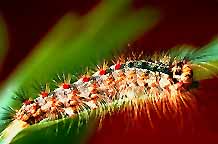Main Content
Article
Gypsy Moth
Gypsy moth

The gypsy moth, Lymantria dispar, is one of North America's most devastating invasive forest pests. The species originally evolved in Europe and Asia and has existed there for thousands of years. In the late 1860s, the European gypsy moth was accidentally introduced near Boston, MA by an amateur entomologist. Since then, gypsy moths have spread throughout the Northeast and into parts of the upper Midwest and Great Lakes states including Indiana.
- Map of Indiana Quarantined Counties (Updated Jan. 2, 2018)
The gypsy moth is known to feed on the foliage of hundreds of species of trees and shrubs in North America but prefers oak trees. When gypsy moth populations reach high levels, trees may be completely defoliated by feeding caterpillars. Several successive years of defoliation, along with contributions by other stress factors, often results in tree death. Gypsy moth can be an expensive, messy problem for homeowners and, when out of control, can cause extensive damage to U.S. forests.
Indiana citizens can help combat this pest by understanding the gypsy moth problem and learning about its management. Please use this website as a source of reliable, current information.
Links
- Slow The Spread
This nonprofit organization was established for the purpose of aiding in the implementation of the U.S.D.A. National Slow the Spread of the Gypsy Moth Project. The National Slow the Spread of the Gypsy Moth Project is part of the U.S.D.A.'s national strategy for the gypsy moth management. - Purdue Entomology Gypsy Moth Site
This web site provides information on the biology of the gypsy moth, what homeowners can do to lessen the effects of the insect, and access to brochures on treatments. - Pest Tracker from NAPIS
This web site publishes survey maps for pests of agricultural and forest commodities and provides links to pest news and information. - Indiana's Strategic Plan for Gypsy Moth
